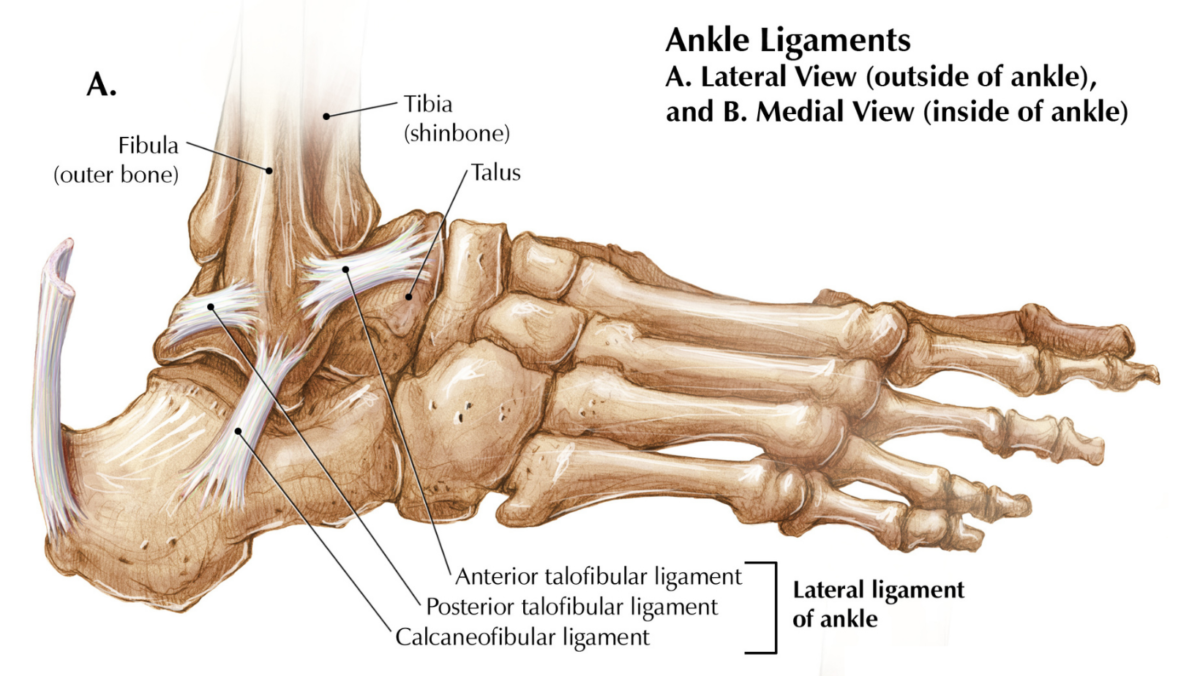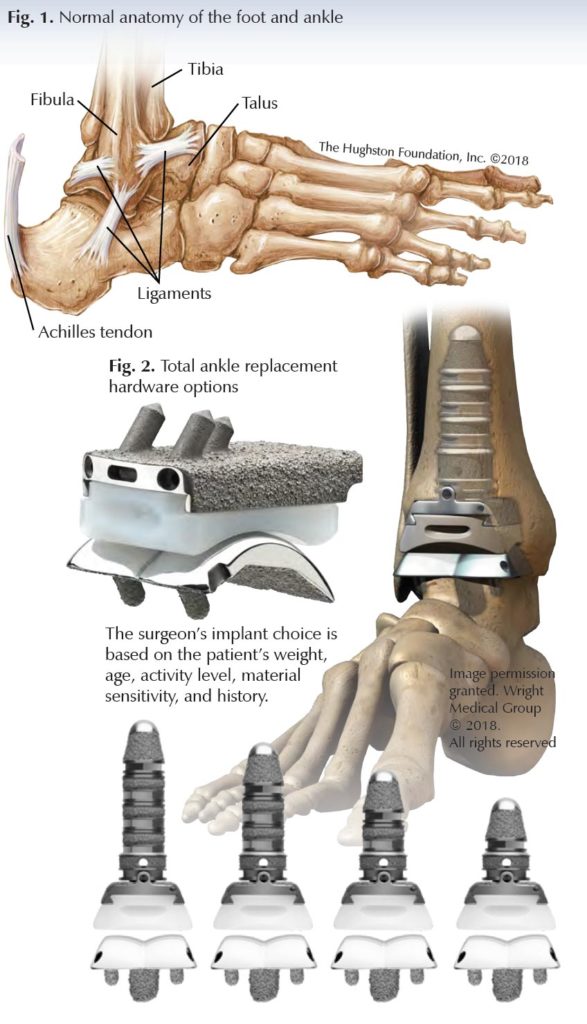Contributing physicians in this story

Total ankle arthroplasty (TAA), also called total ankle replacement, is a surgical procedure that helps to relieve pain and maintain motion in an arthritic or injured joint. The fibula, tibia, and talus bones make up the tibiotalar (ankle) joint (Fig. 1). The talus, which is between the leg and foot bones, articulates with the fibula (smaller bone of the lower leg) and tibia (shinbone). TAA is an alternative treatment to ankle fusion, which can relieve pain, but often limits motion of the joint since the procedure permanently fuses the bones together. Depending on your condition, age, weight, and activity level, your doctor may recommend TAA rather than ankle fusion.

Why does my ankle hurt?
Ankle arthritis caused by degeneration of the cartilage, produces a painful, stiff joint that can affect your quality of life. Whereas arthritis in the knee and hip often results from normal wear and tear of the joint due to aging, ankle arthritis most commonly occurs after trauma to the ankle, whether this is from an ankle fracture, chronic ankle instability, or malalignment of the leg. Only a small percentage of ankle arthritis arises from just wear and tear of the joint alone.
What is the treatment for ankle arthritis?
Initially, physicians treat ankle arthritis nonsurgically with anti-inflammatory medications, physical therapy, bracing, and steroid injections. If these conservative measures fail to provide pain relief and the arthritis continues to affect your ability to do everyday activities, surgical options such as an ankle fusion or TAA can help relieve your pain. Ankle fusion surgery consists of fusing together the bones of the ankle joint. Fusion eliminates motion at the joint and provides pain relief. On the other hand, an ankle fusion can lead to increased stress and wear on the surrounding joints, which can lead to arthritis. This procedure is the gold-standard surgical treatment for ankle arthritis; however, you now have TAA as another option.
What is total ankle arthroplasty (TAA)?
Surgeons perform TAA by removing the arthritic cartilage and part of the bone from the ankle joint and replacing it with metal and plastic components (Fig. 2). The goals of TAA are to alleviate pain and regain the range of motion, which will ultimately improve your quality of life. Another benefit of maintaining ankle range of motion is that the surrounding joints in the foot do not take on any additional stress.
Am I a candidate for TAA?
If you have painful arthritis and nonsurgical treatment has failed, you may want to talk to your doctor about TAA. You are a good candidate for ankle replacement if you have maintained ankle range of motion and have minimal to no ankle deformity. Typically, older patients who place less demand and impact on the ankle joint are great candidates; however, younger patients, in their 50s are beginning to have replacements as well.
TAA is not recommended if you have an active or prior deep infection in the ankle joint, inadequate bone to support the implants, or neuromuscular disease that impairs muscles resulting in poor muscle tone and function in the ankle. Additionally, it’s not recommended to patients who have Charcot neuropathy (loss of sensation in foot and ankle), severe ankle deformity, prior ankle fusion, or poor musculature quality at the surgical site.
How is the surgery performed?
Orthopedic surgeons typically perform TAA using general anesthesia with a nerve block around the knee for postoperative pain control. The doctor places a tourniquet around the thigh to help control bleeding and improve visualization during surgery. The surgeon makes an incision in the front or side of the ankle depending on the type of implant used. Guides are then placed on the bones, and their positions are viewed with an x-ray to determine accurate location before any cuts are made. The surgeon cuts the bones, which allows for the placement of metal and plastic components to recreate the ankle joint. Some patients have tight calf muscles or Achilles tendon (connects calf muscle to the heel bone) that needs to be lengthened to help increase the range of motion at the ankle joint. If that is the case, the surgeon does a lengthening procedure as well. Then the surgeon closes the incisions with sutures or staples, and the ankle is placed in a well-padded splint.
Is there a specific technique that is preferred?
I prefer performing ankle replacements through an incision made in the front of the ankle. This approach allows me to visualize both sides of the ankle joint, which can help in cases of mild deformity and ligament (tissues connecting bone to bone) balancing. The prosthesis company that I use offers multiple options of implants depending on the patient’s anatomy, age, and activity level. One device provides bone-preserving cuts, which maintain good bone stock whereas another implant provides more fixation in both the tibia and talus, especially in cases of ankle deformity or prior ligament damage.
We can now do virtual surgery before going in the operating room. A technologist takes a computed tomography (CT) scan of the patient’s ankle and sends it to the physician. The doctor’s office sends the images to the prosthesis company and engineers map out the exact size of the device to match the patient’s anatomy as well as implant position. Virtual images of the implant size and position are returned to the surgeon in a document, and we are able to view the surgery before entering the operating room. To match the patient’s exact anatomy, patient-specific blocks are also custom made, and are used in surgery to set the cutting guides in the correct position. These guides are very accurate; therefore, we are able to reduce procedural steps, thereby reducing surgical time and increasing efficiency.
What happens after surgery?
After surgery, you will spend 1 to 2 nights in the hospital; however, some surgeons perform TAA as an outpatient procedure either in a hospital or surgery center. After you go home, your physician will give you a strict elevation regimen to follow for several days that helps reduce swelling and improve wound healing. You will be nonweightbearing in a splint or cast for 3 to 4 weeks, and then you can bear weight as tolerated in a walking boot for another 3 to 4 weeks. Typically, after 6 weeks, you can return to a regular shoe and begin physical therapy to work on range of motion and strengthening the ankle. Patients often ask why they cannot walk on their ankle for a period after surgery. Early range of motion in total hip or knee replacement is encouraged because there are no concerns with wound breakdown during early movement. However, this is not the case in total ankle replacements. The skin around the ankle is very thin, especially in the front of the ankle where a tendon lies just underneath the incision. Early motion in TAA causes the tendon to glide back and forth beneath the incision, producing friction, which can lead to wound problems. For this reason, surgeons immobilize the ankle for a short period after surgery to encourage healing of the incision before any ankle movement.
What are the potential complications?
In general, problems that can arise from surgery include blood clots in the leg, infection, excessive blood loss, and complications associated with anesthesia. Some complications that can occur specifically with TAA include fracture of the bone on either side of the prosthesis whether this is the tibia, fibula, or talus. Wound healing can be a problem, especially in higher-risk patients who are diabetic or have peripheral vascular disease (poor circulation) and those who continue to smoke. Implant failure can result if the bone fails to heal to the metal components. As in all total joint replacements, the plastic component between the metal device can wear out, which could result in loosening of the implant from the bone. This typically requires revision surgery to replace the implants for bony ingrowth. Lastly, if the TAA fails, then you may have the option of removing the TAA device and converting the ankle to a fusion.
What are the typical outcomes of TAA?
Patients typically return to their regular activities after TAA. Surgeons generally recommend low impact activities after ankle replacement to prolong the life of the implant. Generally, the TAA device will last 10 years or more. Overall, ankle replacement surgery has come a long way over the past 30 years, and the implants are continuing to be improved.
Author: B. Collier Watson, DO | Columbus, Georgia
Vol. 30, Number 2, Spring 2018
Last edited on October 18, 2021